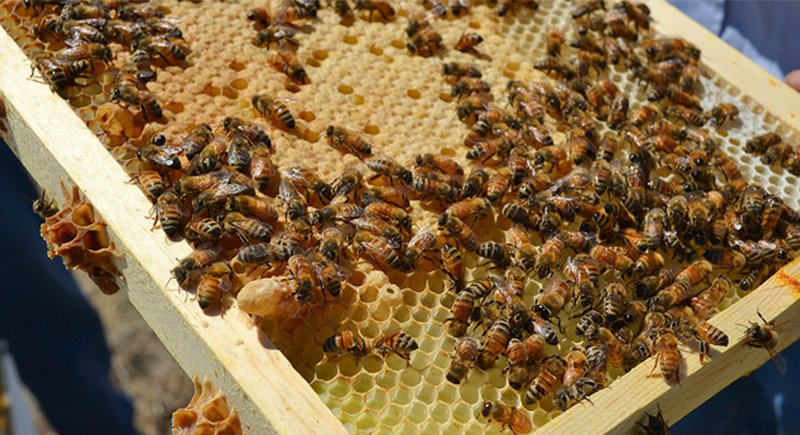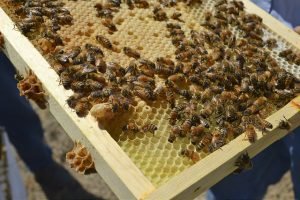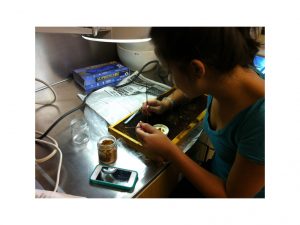
August 15, 2016 Study: Neonicotinoid pesticides pose low risk to honey bees
By Maegan Murray, WSU Tri-Cities
RICHLAND, Wash. – While neonicotinoid pesticides can harm honey bees, a new study by Washington State University researchers shows that the substances  pose little risk to bees in real-world settings.
pose little risk to bees in real-world settings.
The team of WSU entomologists studied apiaries in urban, rural and agricultural areas in Washington state, looking at potential honey bee colony exposure to neonicotinoid insecticides from pollen foraging. The results were published in the Journal of Economic Entomology (http://jee.oxfordjournals.org/content/early/2016/01/19/jee.tov397) this spring.
After calculating the risk based on a “dietary no observable adverse effect concentration” – the highest experimental point before there is an adverse effect on a species – of five parts per billion, the study’s results suggest low potential for neonicotinoids to harm bee behavior or colony health.
Understanding risk vs. hazard
“Calculating risk, which is the likelihood that bad things will happen to a species based on a specific hazard or dose, is very different from calculating hazard, which is the potential to cause harm under a specific set of circumstances,” said co-author Allan Felsot, WSU Tri-Cities professor of entomology and environmental toxicology.
“Most of what has dominated the literature recently regarding neonicotinoids and honey bees has been hazard identification,” he said. “But hazardous exposures are not likely to occur in a real-life setting.”

Felsot said the study shows that the risk of bee exposure to neonicotinoids is small because bees aren’t exposed to enough of the pesticide to cause much harm in a real-world scenario.
Lead author Timothy Lawrence, assistant professor and director of WSU Island County Extension, said many sublethal toxicity studies, whether at the organism level or colony level, have not done formal dose-response analyses.
“The question we posed focused on the risk of exposure to actively managed honey bee colonies in different landscapes,” he said.
Risks in landscapes none to very low
With the cooperation of 92 Washington beekeepers, the team collected samples of beebread, or stored pollen, from 149 apiaries across the state.
 Throughout the one-year trial, neonicotinoid residues were detected in fewer than five percent of apiaries in rural and urban landscapes. Two neonicotinoids, clothianidin and thiamethoxam, were found in about 50 percent of apiaries in agricultural landscapes.
Throughout the one-year trial, neonicotinoid residues were detected in fewer than five percent of apiaries in rural and urban landscapes. Two neonicotinoids, clothianidin and thiamethoxam, were found in about 50 percent of apiaries in agricultural landscapes.
Although neonicotinoid insecticide residues were detectable, the amounts were substantially smaller than levels shown in other studies to not have effects on honey bee colonies. The WSU researchers referenced 13 studies to identify no observable adverse effect concentrations for bee populations, which they used to perform a risk assessment based on detected residues.
“Based on residues we found in apiaries around Washington state, our results suggest no risk of harmful effects in rural and urban landscapes and arguably very low risks from exposure in agricultural landscapes,” Felsot said.
Care required to regulate exposure
While exposure levels were found to be small, Lawrence said it is still important to be careful with use of neonicotinoid insecticides and follow product label directions. For example, insecticides should not be used during plant flowering stages when bees are likely to be foraging.
“While we found that bees did not have chronic exposure to adverse concentrations of neonicotinoids, we are not saying that they are not harmful to bees – they are,” he said. “People need to be careful with pesticide use to avoid acute exposure.”
Other researchers on the study included Elizabeth Culbert, WSU Food and Environmental Quality Lab (GEQL) research technician; Vincent Hebert, WSU associate professor of entomology and laboratory research director; and Steven Sheppard, WSU professor and department chair of entomology.
Contacts:
Allan Felsot, WSU Tri-Cities entomology and environmental toxicology, 509-372-7365,afelsot@tricity.wsu.edu
Timothy Lawrence, WSU Island County Extension, 360-679-7329, timothy.lawrence@wsu.edu
Maegan Murray, WSU Tri-Cities public relations specialist, 509-372-7333,maegan.murray@tricity.wsu.edu




